Pleopodal lungs
Appearance


en endopodite
ep epimeron
ex exopodite
lg pleopodal lung
pp pleopod
pr protopodite
pt pleotelson
ur uropod

Pleopodal lungs are an anatomical feature of terrestrial isopods and a component of their respiratory system. They are ancestrally derived from pleopodal gills, and they facilitate gas exchange on land. They perform a function similar to spiracles in insects.[1][2]
Pleopodal lungs are identifiable on woodlice as white patches on the lower five segments (the pleon) on the ventral side (underside). The number of pleopodal lungs varies by species: they may have up to five pairs, or only two pairs as in Porcellio laevis; a minority of species lack pleopodal lungs entirely.[1]
References
[edit]- ^ a b "Woodlice: 'pleopodal lungs'". British Myriapod and Isopod Group. Retrieved 2020-04-24.
- ^ Unwin, Earnest Ewart (1931). "On the structure of the respiratory organs of the terrestrial Isopoda". Papers and Proceedings of the Royal Society of Tasmania: 37–104. ISSN 0080-4703.
